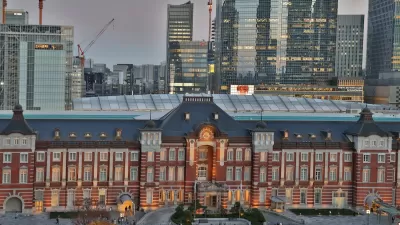An update to Toronto's Tall Building Design Guidelines seeks to address problems with the seven-year-old planning document, while strengthening the protections afforded historic properties, key sightlines, and local context.
"Toronto is more than ever a city of skyscrapers, and so it is prudent they don’t scrape anybody the wrong way," writes Katie Daubs. "A new set of guidelines call for tall buildings to coexist with the rest of the city, by preserving certain views, honouring neighbourhood context and pedestrian experience — and, this one’s small one — but important: by suggesting that balconies have at least 1.5 metres of space and a rectangular persuasion for dining and seating, thank you very much."
"The latest effort come after six years of watching what worked and didn’t work in the past," she explains. "The general content is similar to existing planning documents, with more specific language and changes based on feedback from developers, ratepayer’s groups and citizens. One of the changes is a call for shorter base buildings," says Councillor Peter Milczyn, (Etobicoke-Lakeshore), chair of the planning and growth management committee.
"[Toronto’s director of urban design Robert Freedman] says the guidelines are 'not a checklist' and there is not likely a tower in the city that meets all of them. The idea is that when staff review an application, they should be looking to see if the 'applicant met the spirit and intent of the guidelines.'”
FULL STORY: New Toronto tall building design guidelines aim to protect views of sky, sun, heritage

Alabama: Trump Terminates Settlements for Black Communities Harmed By Raw Sewage
Trump deemed the landmark civil rights agreement “illegal DEI and environmental justice policy.”

Planetizen Federal Action Tracker
A weekly monitor of how Trump’s orders and actions are impacting planners and planning in America.

The 120 Year Old Tiny Home Villages That Sheltered San Francisco’s Earthquake Refugees
More than a century ago, San Francisco mobilized to house thousands of residents displaced by the 1906 earthquake. Could their strategy offer a model for the present?

Indy Neighborhood Group Builds Temporary Multi-Use Path
Community members, aided in part by funding from the city, repurposed a vehicle lane to create a protected bike and pedestrian path for the summer season.

Congestion Pricing Drops Holland Tunnel Delays by 65 Percent
New York City’s contentious tolling program has yielded improved traffic and roughly $100 million in revenue for the MTA.

In Both Crashes and Crime, Public Transportation is Far Safer than Driving
Contrary to popular assumptions, public transportation has far lower crash and crime rates than automobile travel. For safer communities, improve and encourage transit travel.
Urban Design for Planners 1: Software Tools
This six-course series explores essential urban design concepts using open source software and equips planners with the tools they need to participate fully in the urban design process.
Planning for Universal Design
Learn the tools for implementing Universal Design in planning regulations.
Clanton & Associates, Inc.
Jessamine County Fiscal Court
Institute for Housing and Urban Development Studies (IHS)
City of Grandview
Harvard GSD Executive Education
Toledo-Lucas County Plan Commissions
Salt Lake City
NYU Wagner Graduate School of Public Service





























